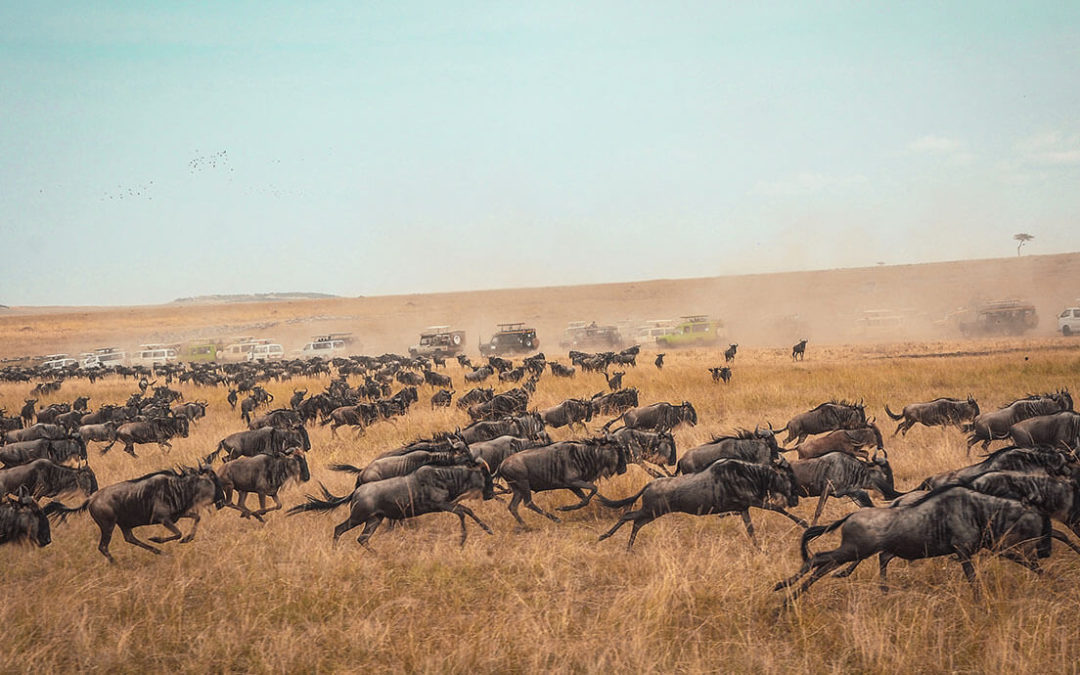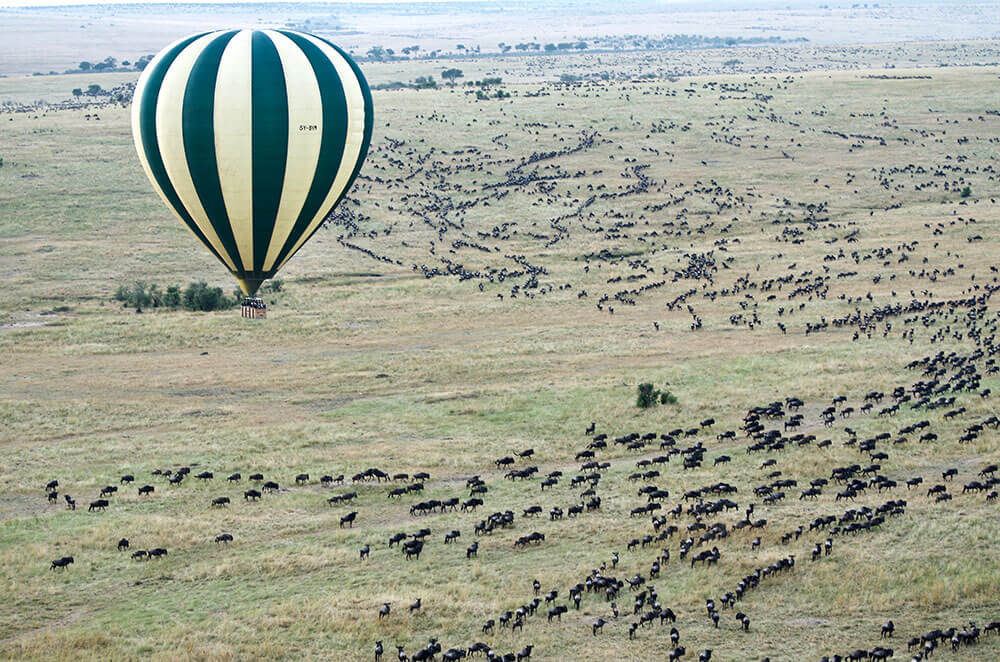From the Serengeti in Tanzania to the Masai Mara in Kenya, these stunning landscapes form the backdrop for the most excellent wildlife show on earth: the Great Migration.
The annual migration attracts thousands of nature lovers, photographers and documentary makers from around the world to experience one of Africa’s most captivating events.
Each year, millions of wildebeest and antelope venture across the plains of Africa in search of new grazing land. This is a sight that is sure to stay with you forever.
We’ve created a detailed guide on what the Great Migration is, why it occurs and when is the best time to witness this unforgettable event.
What is the Great Migration?
The Great Migration is the movement of almost two million wildebeest and 200,000 zebras, gazelles, impalas and other game across the Serengeti in Tanzania to the Masai Mara in Kenya. The animals travel in massive herds in search of freshwater and lush grazing grounds.
This natural phenomenon takes place throughout the entire year, and the journey spans over 3,000 kilometres. The massive herds of wildebeests and various antelope migrate in a circular motion following the annual rainfall in search of better grazing grounds. During the migration, the herds have to dodge hungry predators, including big cats and crocodiles.
Why does the Great Migration happen each year?
The herds of antelope and wildebeest migrate for the sole purpose of following the rain. As rainfall is determined by the seasons, there is no way to predict the exact timing of the rainfall.
- In the Serengeti, the rainy season or long rains spans March, April and May.
- In the Masai Mara, the rainy season is from April to late May.
The onset of the annual rains means that the grass will be greener, and there will be better grazing opportunities for the herds.
The Great Migration generally moves in a circular motion beginning in the Serengeti plains and then to the Masai Mara area in Kenya, and then back again, forming one big circle. The exact route of the migration changes from year to year and is dependent on the rainfall.
When does the Great Migration occur?
Although the herds generally move rhythmically from northwards across the Serengeti, it is difficult to predict where the herds will be on any given day. The animals often zig-zag along the way, and the exact route and timing of the migration will vary depending on the rainfall and grazing conditions.
It can be impossible to predict where the animal’s exact location will be on any given day. Fortunately, we do have a good idea of the patterns and rhythms that the animals move in. To help you plan your Tanzania and Kenya safari in advanced, we have created an outline of when is the best time to experience the Great Migration.
The best time to experience the Great Migration
The migration cycle always begins in the southern Serengeti area for the calving season from December to March. It is estimated that 500,000 calves are born in the Serengeti during a 4-6 window. During this time, a host of hungry predators like lions, leopards and crocodiles are around to take advantage of the easy prey.
December is when the wildebeest begin to assemble together in the South Serengeti plains. They stay here for the next few months, feeding on fresh and nutritious grass.
January and February are when the annual rains hit the Serengeti. At this time, the grass here is lush and ideal for the female wildebeest to give birth and support their young.
By April, the area will have dried out and conditions will be bleak. The massive herds move north for greener grasslands where they begin the mating season.
In June or July, the animals move towards the Masai Mara in Kenya where they encounter the most dangerous part of their journey – the Mara River crossing. Millions of animals frantically cross the fast-flowing and crocodile-infested river, many of which are unsuccessful. This is when visitors can witness an incredible show of nature at its wildest.
From July to September, the migration continues moving northwards. River crossings are best seen during this time as various animals frantically gallop back and forth across the gushing rivers.
From September the animals head back to the Serengeti plains where they started their journey at the beginning of the year, and continue the entire process again.
Facts about the Great Migration
- February is the month with the highest calving rate. Around 8,000 wildebeest are born each day. Between January and March, 500,000 wildebeest are born in the Serengeti.
- Wildebeest and zebras graze together because they each eat different parts of the same type of plant.
- The Serengeti ecosystem is one of the oldest and largest ecosystems on the planet. The area boasts a diversity of plants and animals endemic to the region. This includes animals such as the Rufous-tailed weaver and the blue wildebeest.
- During the migration, approximately 250,000 animals are killed every year by predators, but also from exhaustion, thirst and hunger.
- Thousands of predators follow the migratory patterns of the herds. Newborns attract the predators, and unfortunately, thousands of antelope become the prey. For visitors, this is an epic exhibit of the cycle of life.
- Astonishingly, calves can run with their mothers within minutes of being born and can reach speeds up to 64 km (40 miles) per hour.
The Great Migration is an all-year-round event and, with careful planning, it is possible to catch this phenomenon in action. Visitors can witness the migration from several different safari lodges and tented camps in Tanzania and Kenya. Witnessing this cycle of life is an experience that will stay with you forever.
If you’d like to experience one of the greatest natural wonders on the planet, get in contact with us today to book your trip to one of these dream destinations.



